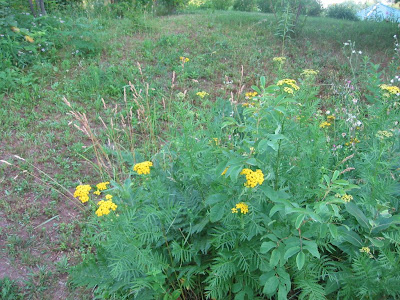


 Thursday, 7:20 AM. 60 degrees, wind W, calm. The channel is beautifully patterned with areas of glassy and rippled water. The sky is partly cloudy and the barometer predicts rain.
Thursday, 7:20 AM. 60 degrees, wind W, calm. The channel is beautifully patterned with areas of glassy and rippled water. The sky is partly cloudy and the barometer predicts rain.Many rather obscure roadside plants are blooming now, most people ignoring them. A ubiquitous plant is the common tansy, Tanacetm vulgare, known from ancient times as a garden and medicinal plant. The leaves have an unusual and not unpleasant, pungent odor. It was used as a strewing herb in Medieval times, when dirt floors were the norm. It was also used medicinally as a tea for various stomach and internal ailments and as a gout remedy (I may try it for that). It has some toxic properties and probably should not be used without sound advice. Its small yellow flower heads give it the English common name of “buttons;” It is prolific and colorful but will take over a garden if you are not very careful. It is best left in nature.
Another common plant of waste places and sometimes a garden weed is nightshade, Solanum dulcamera, also unfortunately called bittersweet, as though it were somehow edible. It is in the same family, the Solonaceae, as the tomato. Don’t taste the attractive red fruits, as they are at least mildly poisonous. It is a semi-woody, climbing plant, and its blue flowers have yellow centers. Children are often attracted to it and it should be eradicated if found around the home.




























































